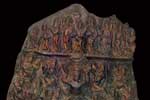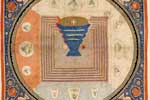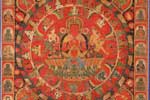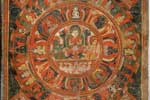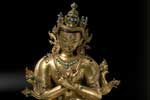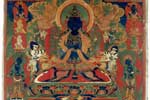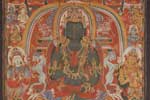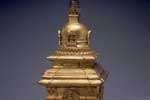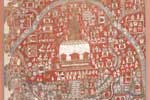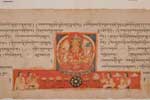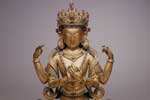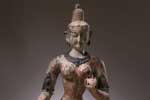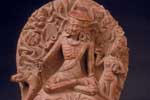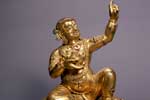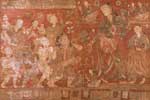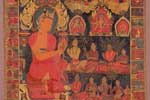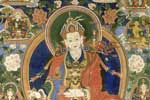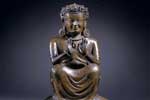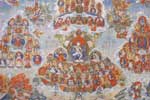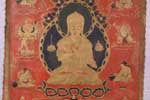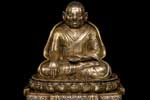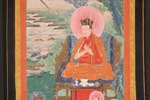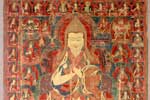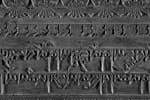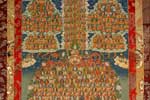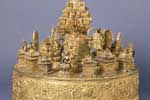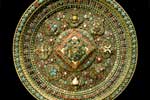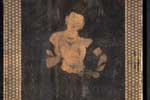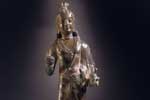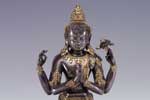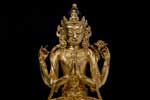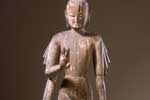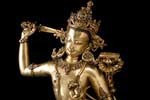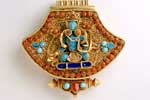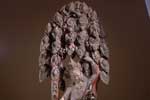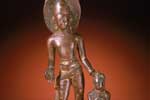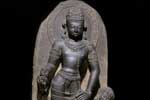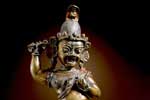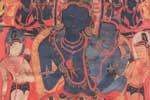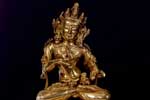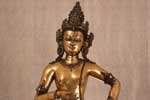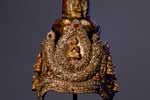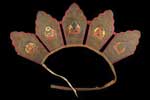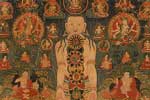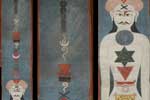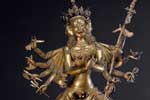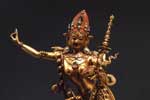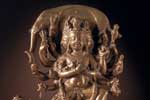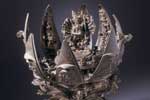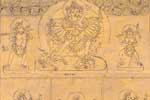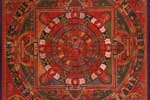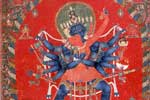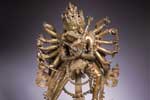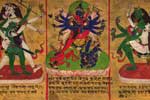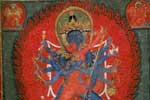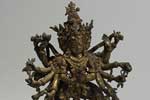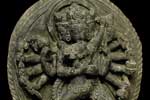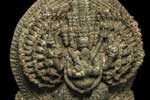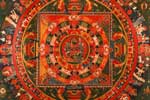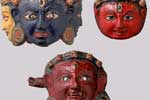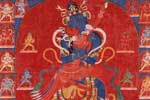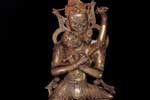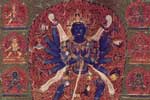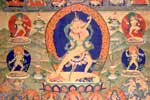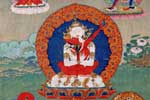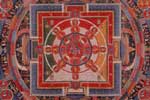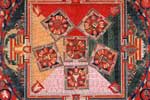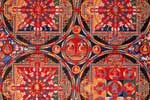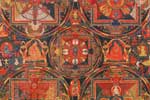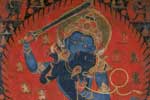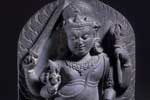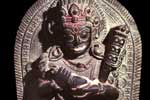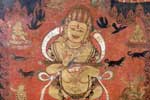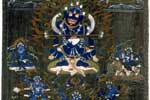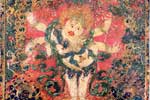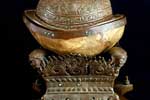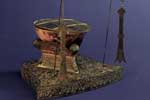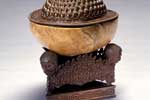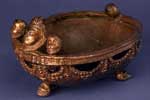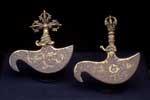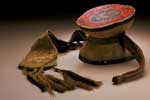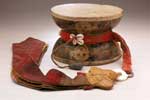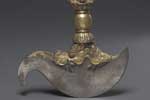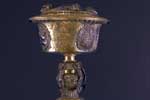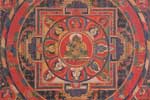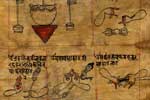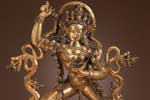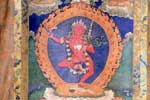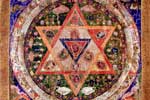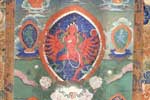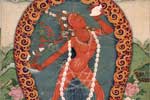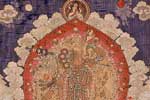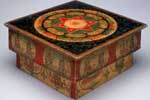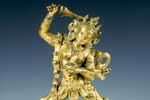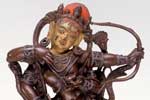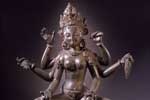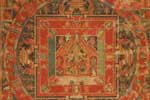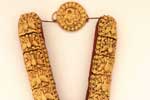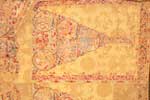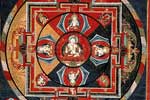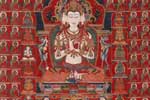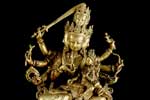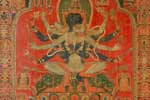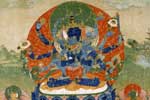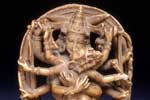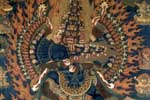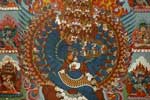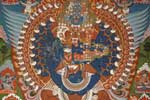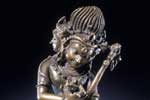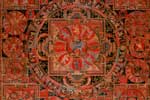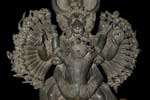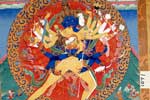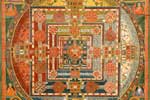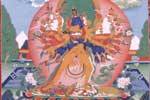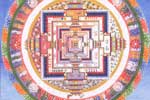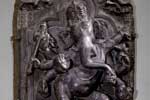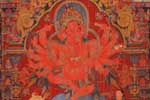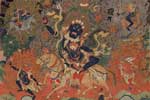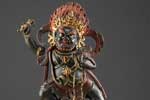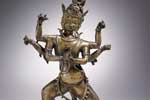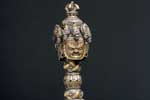
Click on a category listing to expand the content contained within that section
Click on a thumbnail to expand an image to fill your browser's window.
To save an image, either drag-and-drop the expanded image to your desktop, or click on the "DOWNLOAD" link below it.
*Some file sizes are very large and may require extra time in loading

QUICK LINKS
The Potential of Enlightenment:
It is Possible to Attain Enlightenment
Buddhist Cosmology:
Environment of Meditative Transformation
Eternal Dharma:
Primordial Teachers
Goal of the Transformed Mind:
Enlightenment Symbolized
"Mother of All Buddhas":
The Perfection of Wisdom
Beginning the Process:
The Great Masters and Selecting a Teacher
Taking Refuge:
The Commitment to a Buddhist Life
A New Identity:
The Vow of a Being Destined for Enlightenment
The Practitioner as Buddha:
Meditations on Vajrasattva
Secret Instructions for Transformation:
The Subtle Body of Kundalini Yoga
Chakrasamvara/Vajravarahi Introduction
Related Esoteric Tantras
Traditional Benefactors
The Potential of Enlightenment:
It is Possible to Attain Enlightenment-
The attainment of enlightenment is the focus of all Buddhist practice. In the late 6th B.C.E., Siddhartha Gautama attained a state of personal insight that led his contemporaries to recognize him as an "Enlightened Being" (Buddha). After abandoning his life as a prince of the Shakya clan and becoming a wandering ascetic, he attained "Victory over Death," in Bodhgaya, India by renouncing all egoistic clingings of greed, anger, and ignorance. The enlightened state freed him from samsara, the eternal cycles of births and deaths, and allowed him to know that his death would be the final release (parinirvana) from this existence. Subsequently, over a forty-four year period, the Buddha taught the process of attaining this release from the attachment and suffering in the world by practicing the methods of the Middle Way. Thus, Shakyamuni "Sage of the Shakya" serves as the paradigm of this compassionate, illumined state of being to which all Buddhist practitioners aspire.
Buddhist Cosmology:
Environment of Meditative Transformation-
The enlightened state in esoteric Buddhism is attained in the sacred meditational space of Mount Meru. The imagined environment of the Mount Meru world system is an expression of Buddhist cosmology. Conceived as a vast mountain, Mount Meru consists of a series of transcendent residences. The uppermost and most ethereal plane is Akanishta, where innumerable Buddhas reside and where all takings and transformations take place. Simultaneously, Mount Meru is an individual world system, existing only in the heart-mind of the practitioner. It constitutes the center of the Buddhist world system in which each practitioner is but one of billions of people, but at the same time represents each person's "world system," located in the practitioner's own heart-mind. The works of art in this section visually reiterate the centrality of Mount Meru as a fundamental concept in Vajrayana Buddhism.
Eternal Dharma:
Primordial Teachers-
In Vajrayana Buddhism, the primordial Buddha residing in the realm of Akanishta on Mount Meru are the source of all Buddhist teachings (Dharma). Various teachings may have differing primordial Buddhas, but within very narrow limits they each have the same essential meaning—manifesting the totality of the dharma. Of these, Vairochana "Intensely Luminescent One" is the eternal teacher while Vajradhara "Bearer of the Adamantine Scepter" manifests the supreme universality of the enlightened state. Yet both are the embodiment of the "underlying essence" of the Dharma (Dharmadhatu).
In this understanding, it is Shakyamuni as Vairochana, who reveals the secret teachings to the assemblies in Akanishta paradise at the summit of Mount Meru. The two are ultimately identical: Shakyamuni represents a human, historical manifestation of Buddhahood while Vairochana embodies the eternal essence of Buddhahood as manifest in all Buddhas of the past, present, and future. As the primordial source of the enlightened state, Vajradhara is the beatific Buddha that the practitioner becomes during the transformative meditations. Through the realization of the perfected qualities of Vajradhara, the practitioner thus achieves an understanding of the universal. The exquisite works in this section allows a glimpse to the viewer the unknowable state of voidness (shunyata). Goal of the Transformed Mind:
Enlightenment Symbolized-
The five Victor (Pancha Jina) Buddhas collectively symbolize Shakyamuni's enlightened state. Fundamental to the meditational practices, each Buddha represents one aspect of Buddhahood. Together, they offer an abbreviated reference to the qualities and realizations that constitute the totality of enlightenment. As the beatific forms, the Jina Buddhas are envisioned as regal figures residing in paradisal realms of splendor on Mount Meru. Accordingly, they are richly robed, crowned, and ornamented, visually expressing their spiritual attainments.
Symbolizing a conceptual road-map to enlightenment, the five Buddhas are envisioned in fivefold mandala array, with one in the center and the other four inhabiting quadrants in the cardinal directions. The quadrant the Buddha resides informs the viewer which stage of meditation, initiation, transcendent insight, and realization he represents. The fivefold Buddha mandala remains a pervasive motif and unifying principle of esoteric Buddhist art that figural portrayal is not necessary, and just their colors, directions, or symbols may represent them. "Mother of All Buddhas":
The Perfection of Wisdom-
The "Mother of All Buddhas" is the self-named description of a primary body of Buddhist literature known as the Perfection of Wisdom (Prajnaparamita). This text has been personified as a young female Buddha of infinite beauty and wisdom (prajna). As perfected insight, she is the source of all Buddhahood.
The components of enlightenment in esoteric Buddhism are metaphorically symbolized through male and female dualities. The female is perfected wisdom while the male is compassion and skilful means—their meditational unity thus embodies the state of enlightenment. In a more complex understanding, the male aspect also signifies the phenomenal world while the female represents the noumenal world. These polarities coalesce into a single unity, but manifest a state of neutral potential or emptiness (shunyata). It must be understood that the meditator, either male or female, meditationally assumes both roles, to experience the nonduality of the perfected quality. Beginning the Process:
The Great Masters and Selecting a Teacher-
In the secret and dangerous path of Vajrayana Buddhism, the illumined vision and direction of the teacher is fundamental to begin the process. The teacher-disciple relationship is crucial to the propagation of the Dharma, and the teachings are vitalized anew by generation after generation of enlightened masters. Seeing the great teachers (guru) of the past as exemplars and hearing the stories of their learning and teaching exploits prepares the potential practitioner for the most dangerous moment of all—selecting the right teacher. Indeed, there is an intense interpersonal relationship between the religious teacher and the disciple. For the teacher, it is to know if the potential student is a "worthy vessel" to receive the secret teachings and empowerments. For the disciple, it is to know if the potential teacher is an accomplished, compassionate, and enlightened being. Accordingly, the artworks exhibited in this section represent the portraits of great teachers, created in reverence to the great masters who fully realized the Dharma and successfully transmitted it to future generations.
The teacher in Vajrayana Buddhism is called "Esoteric Knowledge Holder," (Vidyadhara) and "Teacher of the Adamantine Path" (Vajracharya), as a living treasury of the esoteric knowledge essential to the disciple's spiritual development. Indeed, the Guru is for the student quite literally a Buddha, an enlightened master who reveals the path to liberation, a repository of all virtues, the source of all blessings. Thus, in the practice of Guru Yoga, the practitioner takes refuge in the teacher along with the Buddha, Teachings, and Community, with the understanding that the Guru is the sum of the Three Jewels, their living embodiment. Taking Refuge:
The Commitment to a Buddhist Life-
There is no more transformative moment in Buddhism than the moment the practitioner takes refuge in the "Three Jewels": the Buddha, the Teachings, and the Community (Buddha, Dharma, and Sangha). As a commitment to the Buddhist way of life, it is a simple personal vow. Once accomplished, the vow is renewed daily before an image or an imagined vision of the teacher. During the visualization meditations, the practitioner takes refuge in the teacher along with the Buddha, Teachings, and Community, with the understanding that the Guru is the sum of the Three Jewels, their living embodiment. Thus, one offers the teacher the Mount Meru mandala as a perfected world system in which the perfect Buddhist teaching environment is envisioned.
A New Identity:
The Vow of a Being Destined for Enlightenment-
In Mahayana and Vajrayana Buddhism, every living being has the capacity to attain enlightenment, because each has the seed of Buddhahood within. The Bodhisattva, "Being of Enlightenment", embodies this paradigm of universal perfection. As perfected beings of immense compassion and wisdom, Bodhisattvas have refrained from their own final death (nirvana) to be reborn time and again, until all other sentient beings have been liberated from endless suffering of rebirth and death. Embodying the universal qualities are the Great Bodhisattvas, as exemplars of the exemplars of the realizations and perfections to be attained along the path to enlightenment.
All Mahayana and Vajrayana practitioners take the Bodhisattva vow, reinforcing the commitment to awaken within themselves the same qualities of altruistic compassion and wisdom as the Great Bodhisattvas. This section will illustrate these Great Bodhisattvas, who have transcended worldliness and, virtually inconceivable in their attainments and supernatural powers, continue to minister to needs the diverse beings still caught in the round of rebirth. The Practitioner as Buddha:
Meditations on Vajrasattva-
The ultimate embodiment of the esoteric Vajrayana path, Vajrasattva means the "Adamantine Being." He and his female aspect are the ideal of the perfected being—without negative karma, without desire, without ego, without self, joined in a perfect egalitarian union of perfect nonduality. The male aspect is absolute compassion and skilful means, while the female is the state of perfected wisdom, as well as, the ultimate goal of Buddhism—the state of voidness (shunyata). Through the accomplishment of complex series of intense meditations, Vajrasattva is actually the practitioner him- or herself in a state of absolute purity, totally cleansed of all hindrances removed and thereby is fully able to realize the nuances of all meditative practices. Thus transformed into the idealized and purified nondual being, the practitioner-Vajrasattva is ready to embark on much longer and far more complex meditations that will sustain him or her further and further along the path of attainment.
Secret Instructions for Transformation:
The Subtle Body of Kundalini Yoga-
Tantric practitioners understand that within the human body is the "subtle body" through which meditative transformations take place. The notion of a subtle body, consisting of a complex interplay of the inner winds (prana), channels (nadi), energy centers (chakra), and drops (bindu), is fundamental to esoteric Buddhist practice. Over a period of months or even years, a practitioner will be trained in the details of the transformative meditations in order to attain the enlightened state and purify all internal hindrances. The meditations is based on the practice of Deity Yoga (Deva Yoga), in which the practitioner visualizes him or herself as identical to the body of the envisioned deity, similarly imbued with the enlightened qualities. The meditations then culminate with awakening latent powers and energies within the subtle body.
The energizing of the subtle body is achieved through yogic practice that arouses the coiled serpent-energy (kundalini) lying dormant in the base of the spine. Like the intense purifying fire of the charnel fields, this forceful energy is transformed into the blazing fire of wisdom, manifested as a goddess. From the lowest chakra, the awakened energy moves up the central channel, activating and purifying each of the chakras. Finally, the energy emerges through the opening at the top of the head, at which point the practitioner experiences the bliss of complete awakening. Thus rising through the energized chakras, the consciousness becomes less and less focused on mundane, egoistic desires, and increasingly concentrated on higher awareness. In the practices of Chakrasamvara meditation, Vajravarahi embodies this purifying inner fire.
To understand the nondual nature of reality, Tantric Buddhism uses the symbolism of dualities—male/female, wisdom/compassion, red/white. In the esoteric tradition, the metaphor of sexual symbolism powerfully explains the nondual state of enlightenment. The male represents the compassion and the phenomenal world, while the female represents wisdom and the noumenal world. In meditations, the male stage is the generation stage and the female the completion stage. Yet, the practitioner must achieve both halves of the meditation to be effective, and once fully realized, the male and female become nondual. Thus, the union of male and female serves as a perfect metaphor to symbolize the state of emptiness (shunyata). Chakrasamvara/Vajravarahi Introduction
-
Chakrasamvara and Vajravarahi embody the enlightened Buddhas of the Highest Yoga Tantras, whose symbolism and meditation are intended to lead the Tantric practitioner directly to enlightenment within this lifetime. To realize the state of enlightenment, the Chakrasamvara practice places special emphasis on the attainment of the radiant light of bliss (prabhasvara) that is generated through the union of Chakrasamvara and Vajravarahi. This process is called devayoga, literally meaning "uniting with the gods," in which the yogin acquires the qualities of the visualized beings and therefore understands his or her identity with the fully realized Buddhas. The meditation begins by visualizing the glorious body of Chakrasamvara, and completes with the visualizations of Vajravarahi, as the inner purifying fire. Through this process, the meditator experiences the great bliss (mahasukha) of complete enlightenment. This state of absolute nonduality—the cessation of all desire and quiescence of all egoistic constructs—is nowhere more powerfully symbolized than by the union of Chakrasamvara and Vajravarahi. Their eternal and indivisible union forcefully unites wisdom and compassion into a completely realized state of nonduality. Within their one enlightened mind, there is only altruistic compassion and complete insight into the Dharma.
The method is to imagine a sequence of stages and transformations and to practice them repeatedly until they are completely internalized. At each stage, the works of art aid the the practitioner to understand the iconography and interpretive symbolism of Chakrasamvara/Vajravarahi as well as the sixty-two deities of the Chakrasamvara mandala. Like any great performance, the meditational visualizations take practice to perfect these stages and follow the very detailed instructions from the Guru.
Consequently, following the Tantric paradigm, these intense meditations require preparatory empowerments and initiations from a qualified Tantric teacher before the yogin can undertake any details of the meditation. Once initiated, the practitioner is free to practice the meditation as often as the individual and his or her Guru feel is appropriate. Indeed, it is only through a profound understanding of the iconographic symbolism through the works of art as tools of meditation that the yogin is prepared to experience the clear light of bliss within this lifetime.
Chakrasamvara
Exoteric Forms of Chakrasamvara
For the Tantric Buddhist practitioner, access to Chakrasamvara practice and meditation requires full initiation. Yet, the highly esoteric deity Chakrasamvara also manifests himself in his alternative benefactory forms to aid in the mundane and more immediate this-worldly needs of the uninitiated practitioners. Little-known in the art historical context, Achala and Mahakala are two of his exoteric aspects, and the works of art displayed will demonstrate their special relationship to Chakrasamvara practice.
Ritual Implements
Vajravarahi
As the yogin concludes the generation stage meditations and visualizes the complete mandala of Chakrasamvara, he or she is ready for the completion stage practices of Vajravarahi. She represents the inner fire that purifies and burns all negativities of the subtle body, until all energy centers (chakra) are gradually awakened. As Vajravarahi, the meditator is meant to embody the dynamic energy and vitality of the goddess and works of art are meant to capture the fundamental essence of this Dakini. She is the source of the great bliss (mahasukha) of complete enlightenment and, through Vajravarahi, the practitioner realizes the true nature of the Circle of Bliss.
Exoteric Forms of Vajravarahi
Like Chakrasamvara, Vajravarahi has exoteric forms that allow practitioners to have immediate access to her benefactory powers. In Newar Buddhism, two important "public" faces of the secret deity Vajravarahi are Kumari, the child-goddess human manifestation, and Vasundhara, the goddess of wealth and fecundity. For the first time, these aspects are brought to light in the context of the artworks and their relationship to popular ritual practices.
Related Esoteric Tantras
-
Introduction
Since Tantric Buddhist practitioners have varying levels of understanding and spiritual advancement, the Tantras are divided into groups that best address the needs of the practitioner at his or her particular level of accomplishment. The methods elaborated in the Tantras are specific instructions that aid the practitioner in realizing the true nature of reality through yogic contemplation and meditation. Characteristic of this path are the sonic power of mantras, the performative aspects of gestures (mudras), sacred diagrams of mandalas, and mental visualizations, which purify the body, speech, and mind enable the practitioner to attain enlightenment within this lifetime.
The Tantras are divided into four basic categories in order of increasing complexity. They are Action Tantras, Performance Tantras, Yoga Tantras, and Highest Yoga Tantras.
The Kriya Tantras aim at material benefits, through blessings obtained from the individual deities. The Charya Tantras emphasize internal meditation as an effective means to enlightenment. The meditation is based on visualizing oneself as that deity, a practice that develops in the Yoga Tantras. The Highest Yoga Tantra, to which the Chakrasamvara Tantra belongs, continues and refines the process.
The Highest Yoga Tantras comprise the shortest path to enlightenment, attained within one lifetime, through intense yogic transformations and instructions that are provided by a qualified teacher. Whereas the practices taught in lower-class Tantras may take multiple lifetimes to achieve ultimate realization, the methodologies described in these Tantras are esoteric, efficacious, and powerful, yet extremely dangerous without the proper instructions. The process is one of internal transformation, in which the practitioner experiences the attainment of enlightenment through awakening the energy centers of the subtle body and purifying the internal winds to physically identify oneself as the enlightening being. This section will highlight the major related Tantras, such as the Guhyasamaja, Hevajra, Kalachakra, Namasangiti, and Sarva Durgati Parishodhana Tantra.
Sarva Durgati Parishodhana
Namasangiti
Guhyasamaja
Mahottama
Hevajra
Vajrabhairava
Kalachakra
Traditional Benefactors
-
Deities in the Buddhist pantheon not only embody the highest qualities of an enlightened being, they also serve as great benefactors and protectors of the mundane and spiritual realms. Known as Dharmapalas, "Dharma Protectors," these deities are important in the Himalayan Buddhist pantheon as powerful guardians of the Buddhist Dharma. Many are often non-Buddhist in origin, who have converted to Buddhism and serve as major protectors of the Buddhist faith. These wrathful benefactors are both propitiated for the most mundane of motivations as well as invoked to aid the practitioner in removing the spiritual obstacles in the attainment of the enlightened state.
As benefactors, Dharmapalas truly serve as manifestations of compassion, and both their wrathful attitudes and the symbolic weapons they hold are directed against the obstacles of Buddhism, allowing spiritual advancement. The strength and energy issuing forth from the presentations of wrathful deities embody the power that is necessary for cutting through all hindrances in order to reach the ultimate goal. Thus, the angry forms of Dharmapalas are wrathful emanations, or protective aspects, of enlightened Buddhas. They are embodiments of enlightened activities; the energy and power of these fierce aspects take into action the Buddhas' limitless compassion for the benefit of all sentient beings. Therefore, the wrathful representations of the benefactors symbolize a resort to power, which becomes necessary when one is unable to break the wall of ignorance through conventional and peaceful ways.


